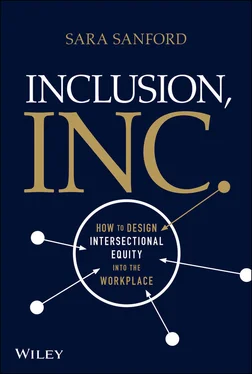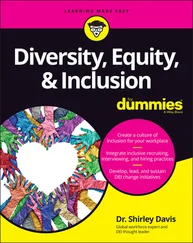Emilio J. Castilla, one of the study's lead researchers, wondered if telling employees that they worked in a company that rewards merit impacted employees' behaviors. In partnership with Indiana University Sociology Professor Stephen Bernard, he conducted a series of lab experiments that all led to the same outcome: When companies emphasized “meritocratic values” to employees as part of their core identity, managers were more likely to award larger “performance-based” bonuses to male employees than to equally performing female employees.
Much in the same way that attending a training could make employees feel they had gained moral capital, being told they worked for a meritocracy made them more likely to believe they were making merit-based decisions. They felt their decisions were impartial and correct, by proxy. Taking fairness for granted, though, actually allowed bias to dilute merit, rather than enhance it. Castilla and Bernard named this phenomenon the “Paradox of Meritocracy.”
When businesses put processes in place, however, to ensure that they don't overlook valuable individuals, the benefits compound in a surprising way. Underestimated employees don't just add their own talents to the workplace—they amplify the talents of their co-workers. We can look to the 2002 Oakland Athletics for an example of how this plays out.
Baseball Biases and the Power of the Collective
In the Athletics' year of Moneyball fame, Billy Beane made a $44 million ball club competitive with the $125 million New York Yankees. The key to Beane's success? He saw the value in players that the market had traditionally undervalued, and he brought complementary players together to bring out one another's strengths.
For decades, baseball franchises had been relying on a narrow set of metrics—stolen bases, home run averages, and batting averages—for scouting valuable players. Beane decided to widen the scope of what could be considered valuable. He and his scouts searched for players who performed well against metrics that typically go unnoticed, such as on-base percentage and slugging percentage (the number of bases a player gains each time he's at bat). These methods of player evaluation flew in the face of conventional scouting wisdom, but Beane's strategy proved successful.
Having players with higher on-base percentages meant that when a home run hitter came to bat, the odds were greater that another player would already be on base. This meant that hitting a home run would knock in two runs instead of one. Players with high slugging percentages were more likely to be on second base, rather than first, increasing the odds that they would make it home if the next batter hit a single.
The underestimated strengths that these players brought to the team amplified the benefits of more traditionally valued players. If you evaluated the team as an average of the players' metrics, it didn't look good, but the players' complementary strengths reinforced each other, creating a team that was greater than the sum of its affordable parts.
Beane fielded a team with a diversity of skills that was as powerful, collectively, as teams that were spending three times as much on traditional all-star players. This once controversial approach has now become widespread; historically undervalued metrics, such as on-base percentage, are now accepted as statistically strong indicators of a team's overall offensive success. These undervalued talents just needed to be given a chance.
Any business leader would jump at the opportunity to unlock the same rewards as their competition at a third of the price. But does this method translate? Carnegie Mellon Organizational Psychology Professor Anita Williams Woolley wanted to find out.
From Baseball to Business
In her research, Woolley had seen that managers tended to think of team performance as the average of each individual member's performance. Just as baseball clubs had historically depended on a narrow definition of what “success” looked like, though, managers only seemed to recognize and select the same kinds of all-stars, over and over again. Traits such as extroversion or public speaking were easily recognized as desirable, while other traits, such as emotional intelligence or long-term thinking, tended to go unnoticed. This often led managers to build teams with strengths that were redundant, rather than complementary.
Woolley wanted to test how groups stacked with these traditionally recognized all-stars performed as a collective , compared to teams with more diverse skill sets. 24 Woolley brought teams into a lab and studied how they, as groups, tackled a series of tasks, such as playing checkers, solving logic puzzles, and debating the ethics of complicated moral problems. She gave each group a collective intelligence (CI) score based on how well they navigated these challenges. She also assessed each group's average intelligence (AI), meaning she averaged the individuals' scores across metrics traditionally considered to be indicators of success.
The groups that had the highest CI scores, meaning they performed the best on this series of tasks, were more diverse, had higher social sensitivity scores, and took steps to ensure that everyone in the group had a chance to contribute. The groups with the highest AI scores performed worse.
The same groups were then given a more complicated second round of tasks. Those groups with higher CI scores again outperformed groups with high AI scores in these more challenging scenarios.
Wooley concluded that when complementary intelligences were combined, they amplified one another, and outperformed teams with higher average scores in historically valued areas. While one team member may have had a technical understanding of a problem, another may have had unique experiences that revealed certain solutions wouldn't work in certain contexts, and a third may have had the social intelligence to make sure the two of them communicated their ideas clearly to each other. Alone, these forms of intelligence weren't as effective as when brought together. Just as players who got on base helped home run hitters score two runs instead of one, those with undervalued talents brought the intelligence of the collective to its full potential.
The power of a diverse collective has proven key to helping ball clubs and businesses multiply their impact. As a society, what are we missing out on by overlooking the undervalued? One Wall Street pacesetter believes that harnessing the power of the collective could have kept us from reliving the largest financial crash since the Great Depression.
Sallie Krawcheck, the founder of the Ellevate Index Fund, has been called by many the “most powerful woman on Wall Street.” She is also known for her widely public firing from Citigroup. In Krawcheck's assessment, her dismissal wasn't due to her gender, but to the problem of “groupthink,” which she ascribes to the lack of diversity on Wall Street. Her firing came after she pushed Citi's then-CEO, Vikram Pandit, to reimburse Citi's clients who lost large sums on investments that Citi had marketed as low risk.
Her assessment: She was punished for speaking out against the majority opinion. Wall Street's lack of diversity, she argued, created a “false comfort of agreement” from pervasive groupthink.
“There is no doubt in my mind that was a cause,” Krawcheck told CBS MoneyWatch . “I didn't see evil geniuses who perfectly foresaw the crisis, and I was at the table. They really believed what they were saying—that the risk was dispersed, that they didn't have much on their balance sheets.”
Krawcheck became one of the first high-profile figures to speak out publicly about how different the economy of 2008 might have looked if, instead of the Lehman Brothers, we had had the Lehman Siblings at the helm. She believed that greater gender diversity, which tends to correlate with greater cognitive diversity, would have helped to avoid the groupthink that caused the bubble to burst.
Читать дальше












